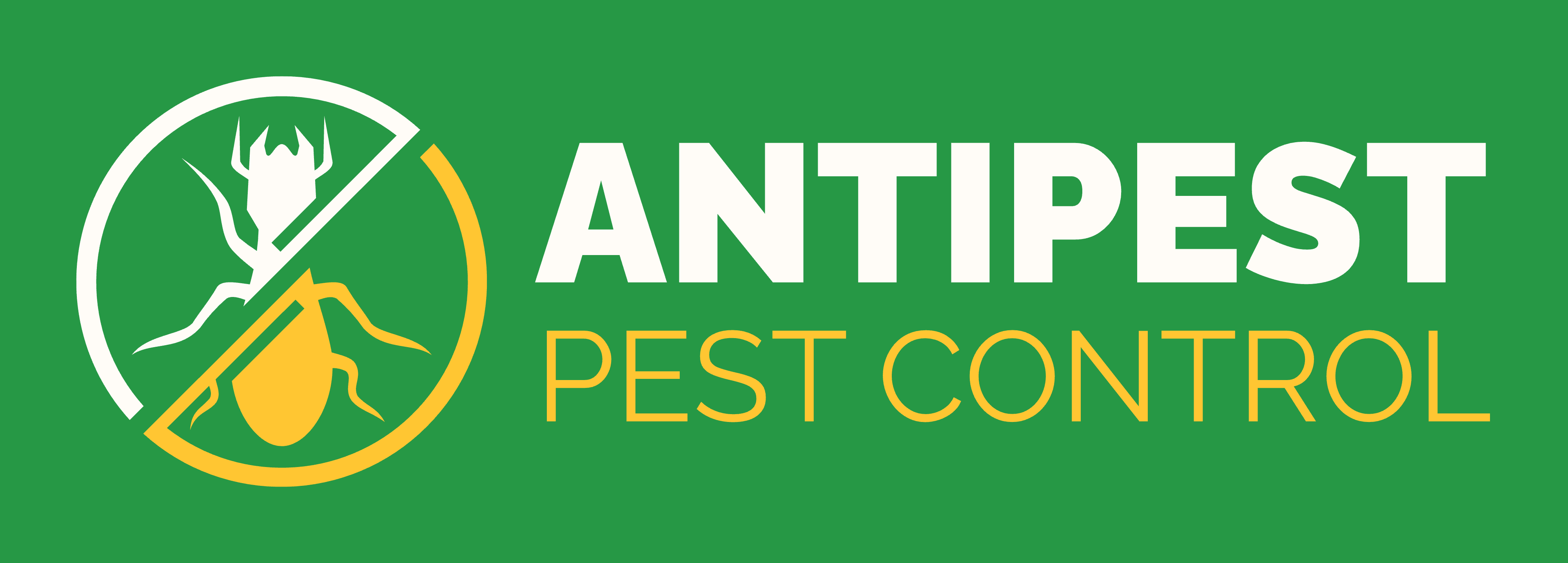Fire ants are one of the most stubborn and aggressive pests found in gardens, lawns, and sometimes even inside homes. Knowing how to get rid of fire ants is crucial for protecting your family, pets, and plants from their painful stings and damage. These ants build large, unsightly mounds, attack in groups, and can cause severe discomfort. If you’ve ever seen them invade your yard or crops, you know how frustrating it can be.
In this guide, we’ll break down effective and practical methods to permanently control these pests. By the end, you’ll clearly understand not just how to get rid of fire ants, but also how to prevent them from returning.
Table of Contents
Understanding Fire Ant Behavior
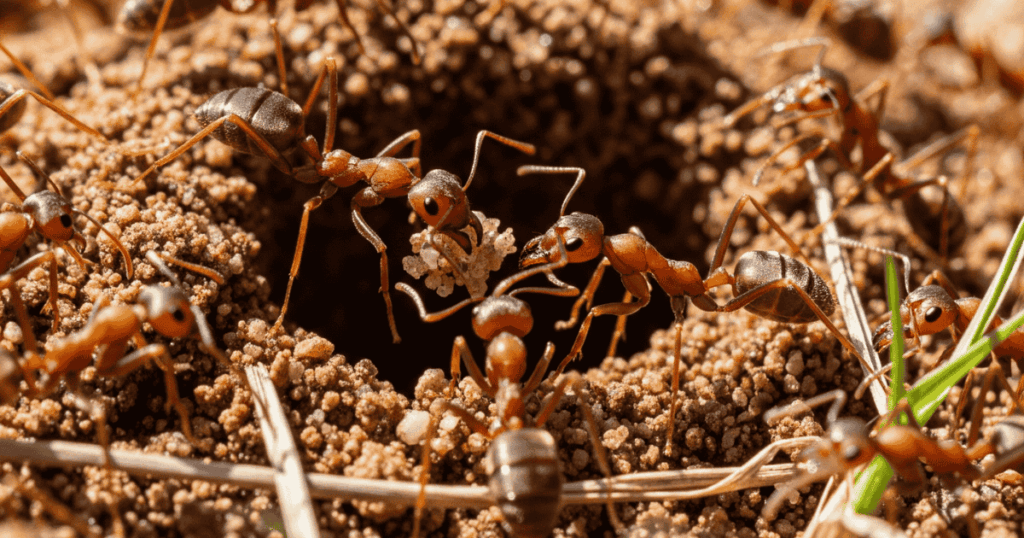
Before exploring methods on how to get rid of fire ants, it’s important to understand their habits. Fire ants usually build their nests outdoors but may invade homes during heavy rains. They spread rapidly, and disturbing a mound often leads to aggressive swarming. Their colonies have one or multiple queens, making eradication challenging if only surface workers are targeted.
Key Characteristics:
- Aggressive and sting when disturbed.
- Build dome-shaped mounds in soil, lawns, or gardens.
- Colonies can contain thousands of ants.
- Can survive floods by forming floating clusters.
This knowledge ensures you attack the root of the infestation, not just the visible surface.
Signs of Fire Ant Infestation
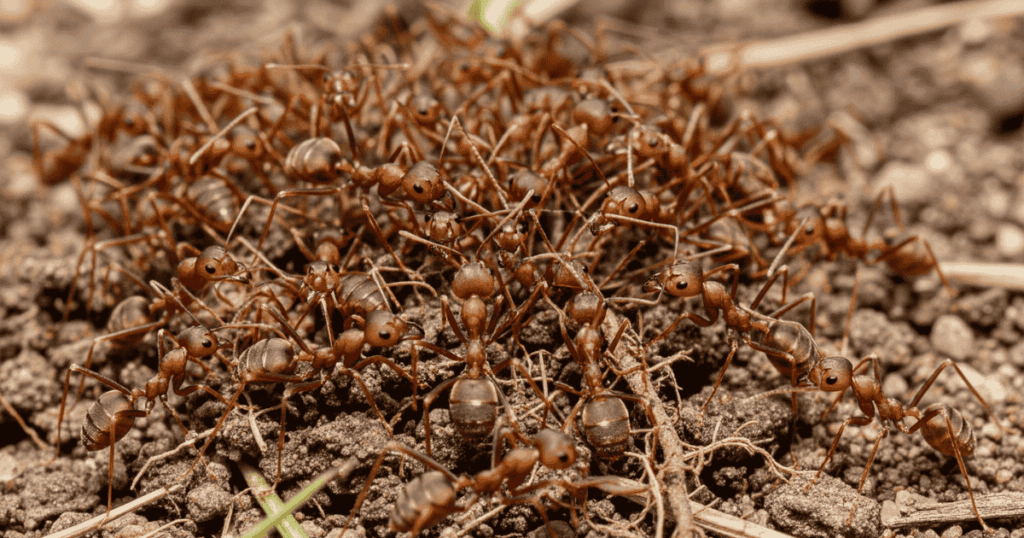
Spotting fire ants early makes it easier to tackle their spread. Homeowners often overlook the first signs until mounds multiply. By learning what to watch for, you’ll know exactly when to act. Identifying the signs of fire ant infestation can help you take control before the problem worsens. Once you notice these indications, it’s time to act fast on how to get rid of fire ants effectively.
- Visible mounds: Large dome-shaped soil mounds with no central hole.
- Aggressive stings: Painful multiple stings when disturbed.
- Damage to lawns: Patches of dead grass and soil disturbances.
- Animal impact: Pets may suffer painful stings and allergic reactions.
Here’s a quick table for easy reference:
| Sign | Description |
| Mounds | Dome-shaped, loose soil with no visible holes |
| Stings | Painful, pustule-forming stings that burn |
| Lawn Damage | Yellow patches and disrupted soil |
| Animal Impact | Pets may get stung and swell |
How to Get Rid of Fire Ants Effectively?
Knowing how to get rid of fire ants effectively starts with targeting both the workers and the queen. Surface sprays alone may kill ants you see but leave the colony intact. That’s why professionals recommend granular baits, mound drenches, or insect growth regulators that attack reproduction. If you want to understand how to get rid of fire ants effectively long-term, combining these tools with regular prevention will ensure they don’t return.
- Use granular baits that target the queen for colony elimination.
- Apply mound drenches to kill visible ants and underground chambers.
- Consider insect growth regulators to stop new ants from maturing.
- Combine treatments for stronger results.
- Maintaining yard hygiene ensures you know how to get rid of fire ants effectively.
| Method | Application | Benefit |
| Granular Baits | Spread across yard, carried to queen | Long-lasting elimination |
| Mound Drench | Pour liquid into mound | Immediate results |
| Insect Growth Regulators | Added to soil as bait | Prevents colony rebuild |
| Combination | Two-step method | Best for heavy infestations |
How to Get Rid of Fire Ants in Your Yard?
When deciding how to get rid of fire ants in your yard, your approach should focus on covering large areas because fire ants often form multiple colonies. Broadcast bait is highly effective since worker ants spread it, reaching hidden mounds you can’t see. Another useful way is treating visible mounds with a drench. If you plan carefully, knowing how to get rid of fire ants in your yard ensures both safety for pets and long-term lawn health.
- Apply broadcast bait evenly in affected areas.
- Treat visible mounds directly with liquid solutions.
- Mow and water lawns regularly to discourage colonies.
- Remove yard debris to prevent nesting.
- Following these steps ensures you know how to get rid of fire ants in your yard effectively.
| Action | How It Helps | Best Use |
| Broadcast Bait | Covers large lawn areas | Multiple colonies |
| Mound Drench | Targets specific mounds | Visible infestations |
| Lawn Care | Mowing, watering evenly, aeration | Prevention |
| Debris Removal | Eliminates hiding spots | Long-term protection |
Natural Home Remedies to Remove Fire Ants
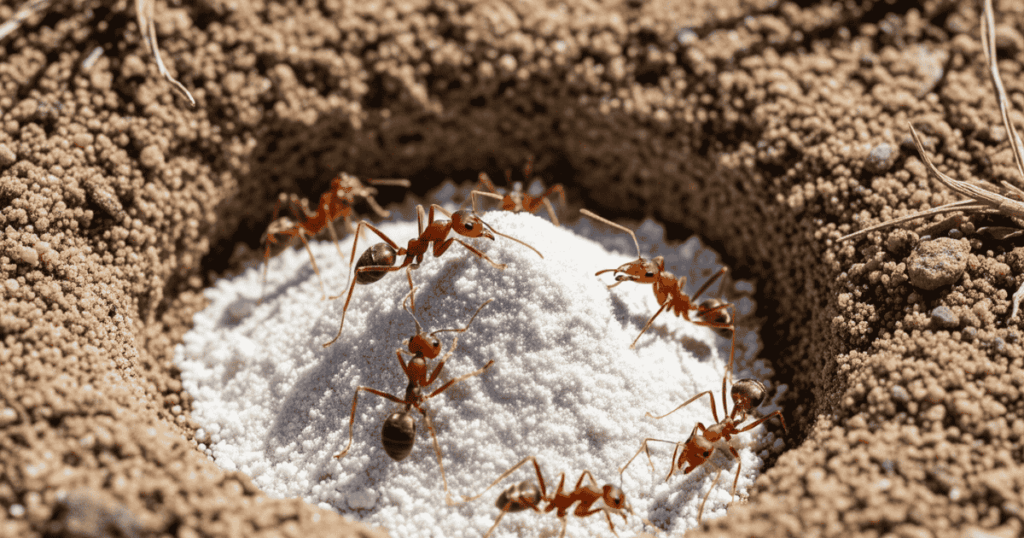
If you prefer eco-friendly approaches, learning natural home remedies can help you figure out how to get rid of fire ants without harsh chemicals. Boiling water poured into mounds kills many ants instantly, but may need repetition. Food-grade diatomaceous earth is another safe choice that dries out ants naturally. Vinegar sprays can disrupt scent trails, making colonies disorganized. While slower than chemical methods, natural home remedies remain an excellent choice if you want to understand how to get rid of fire ants safely.
- Pour boiling water directly into the mound.
- Use diatomaceous earth for safe and natural drying.
- Apply vinegar and water spray to break ant trails.
- Repeat natural methods multiple times for lasting results.
- Eco-friendly steps show how to get rid of fire ants naturally in homes and yards.
| Remedy | How It Works | Safety Level | Best Use |
| Boiling Water | Destroys ants immediately | Safe, but risky to handle | Small mounds |
| Diatomaceous Earth | Dehydrates and kills ants naturally | Pet and child safe | Around garden beds |
| Vinegar Spray | Disrupts pheromone trails | Safe indoors/outdoors | Trails and cracks |
| Repetition | Multiple applications | Safe natural method | Long-term eco-friendly control |
How to Get Rid of Fire Ants Naturally?
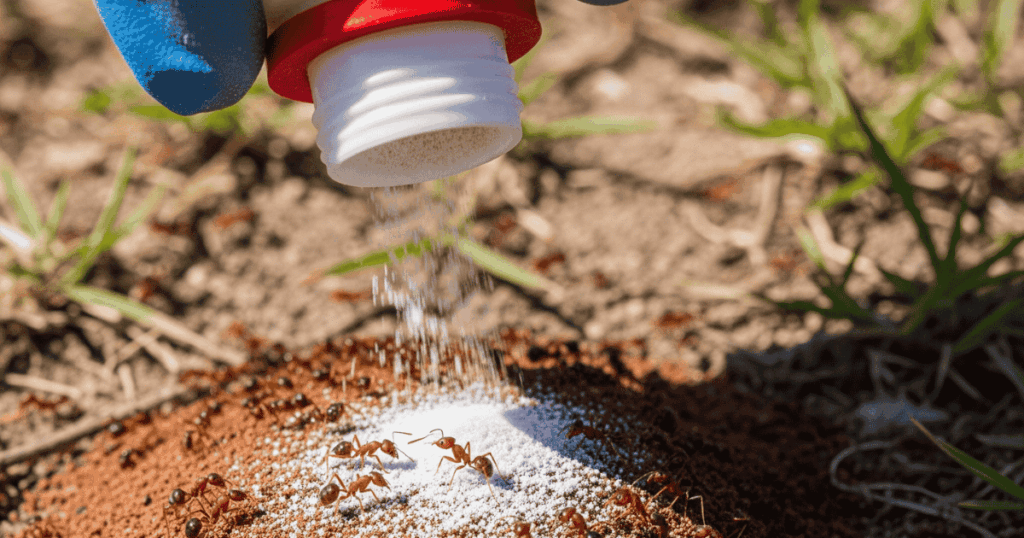
Natural methods are ideal if you want a safe solution for children, pets, or your garden. Here are effective eco-friendly techniques for how to get rid of fire ants without harsh chemicals.
Boiling Water Treatment
Pouring hot water directly into the mound can destroy large portions of the colony. Repeat treatments may be necessary for complete elimination.
Vinegar Spray
Mix equal parts of vinegar and water. Spray the solution directly into mounds or onto entryways to disrupt their trails and colonies.
Diatomaceous Earth
This fine powder damages the ants’ exoskeleton when they crawl over it, leading to dehydration and death. Sprinkle around nests and entry points.
Essential Oils
Peppermint and orange oil are natural repellents. Mixing them with water and spraying directly on nests helps break colonies apart naturally.
Citrus Peel Spray
Citrus oil damages fire ants’ respiratory systems. Blend citrus peels with water, let it ferment overnight, and pour on mounds.
Cornmeal Baits
Fire ants can’t digest cornmeal properly. Sprinkling it around their trails starves them over time.
Chemical Treatments on How to Get Rid of Fire Ants?
When natural methods aren’t enough, chemical solutions may be required. These are among the most widely discussed approaches for how to get rid of fire ants effectively and thoroughly.
- Granular Baits
Ants carry bait granules back to the colony, eventually killing the queen. Effective brands include insecticides with hydramethylnon or spinosad. - Liquid Insecticides
Sprayed treatments directly target fire ant trails and mound entrances for quick results. - Dust Formulations
Insecticidal dust penetrates mounds and is effective in dry conditions. - Insect Growth Regulators (IGRs)
Slow-acting, they prevent future ants from maturing, leading to colony collapse.
| Treatment | How It Works | Best For |
| Granular Bait | Workers carry bait to queen | Long-term elimination |
| Liquid Spray | Direct contact kills ants | Small colonies, visible trails |
| Dust | Kills internally when spread | Dry soil conditions |
| IGR | Prevents reproduction | Entire colony control |
Comparison Between Natural vs. Chemical Solutions
| Method | Pros | Cons | Best Use Case |
| Boiling Water | Cheap, immediate effect | May not kill queen, repeat needed | Small mounds in gardens |
| Vinegar | Eco-friendly, safe for pets | Limited effectiveness | Indoor entry points / trails |
| Diatomaceous Earth | Non-toxic, long-term prevention | Slow acting, needs dry conditions | Around flowerbeds or food areas |
| Chemical Baits | Targets entire colony and queen | Takes time to show results | Large outdoor infestations |
| Insecticide Drench | Fast and direct elimination | Requires careful chemical handling | Mounds near lawns and patios |
| Granular Treatment | Prevents future infestations | Needs reapplication | Broad lawn protection |
Preventing Fire Ant Reinfestation
Knowing how to get rid of fire ants is important, but prevention helps you avoid recurring problems. Taking a few precautions greatly reduces the chances of reinfestation.
Lawn and Garden Maintenance
Regularly mow your lawn, remove debris, and keep soil aerated. Fire ants thrive in undisturbed, moist areas.
Seal Entry Points
Inspect homes for cracks or gaps near doors, foundations, or pipes. Seal them with a caulk to block ants from entering.
Eliminate Food Sources
Keep pet food indoors, store sweet substances in airtight containers, and dispose of trash frequently to reduce attractants.
Control Moisture
Fix leaking hoses and clogged drains. Moist conditions attract fire ants to set up new colonies nearby.
Home Safety Tips During Ant Control
Fire ants are aggressive and capable of inflicting painful stings. While applying control measures, safety precautions must be followed to minimize risks.
- Wear gloves and protective clothing when tackling mounds.
- Avoid disturbing nests unnecessarily as this triggers swarming.
- Keep children and pets away during treatment.
- Wash tools, containers, and sprayers after application.
Following these tips ensures you remain protected while learning how to get rid of fire ants effectively.
DIY vs Professional Fire Ant Control
Trying to decide whether you should handle fire ants on your own or hire an expert? Both options have pros and cons depending on the extent of the infestation.
DIY Control
- Cost-effective for small infestations.
- Effective when using natural or chemical baits consistently.
- Limited success with large colonies.
Professional Control
- Experts have stronger, regulated solutions.
- Long-term management through scheduled visits.
- Best for yards with multiple, fast-spreading mounds.
| Approach | Advantages | Limitations |
| DIY | Low cost, uses household remedies, direct control | Time-consuming, may need repeated tries |
| Professional | Strong chemicals, guaranteed coverage | Higher cost, requires scheduling |
Cost Comparison of DIY vs Professional Treatment
| Treatment Type | Average Cost Range | Pros | Cons |
| DIY Natural Remedies | Low (₹100–₹500) | Safe, affordable, eco-friendly | Requires repeated effort |
| DIY Chemical Solutions | Moderate (₹500–₹2000) | Effective, fast control | Risk of misuse, not child-safe |
| Professional Services | High (₹2000–₹8000) | Thorough, long-lasting, hassle-free | Costlier than DIY, requires scheduling |
When to Call Professionals to Get Rid of Fire Ants?
Sometimes DIY solutions don’t provide complete relief. In such cases, pest control professionals may be the most reliable option for how to get rid of fire ants. Professionals use industrial-strength insecticides and advanced tools that penetrate deeper into colonies. They also provide long-term preventive treatments.
Consider calling a licensed professional if:
- Multiple large mounds appear across your property.
- You’ve faced repeated infestations despite DIY control.
- Fire ants are nesting dangerously close to your home or children’s play areas.
For comprehensive and hassle-free Fire Ant removal and long-term pest prevention, trust the professionals at Antipest Office. Visit us at the Antipest Office, Our trained technicians use safe and effective methods to protect your home and business. For service bookings and consultations, call us at +91 9819018398 .
Conclusion
Learning how to get rid of fire ants involves a mix of identification, treatment, and prevention strategies. Natural remedies like boiling water, vinegar, and essential oils are safe, while chemical baits and insecticides provide stronger results. Combining prevention with control is the best long-term approach. If infestations are severe, professional help becomes essential. By staying proactive, you can protect your home, garden, and family from these aggressive pests. Remember, the real key in how to get rid of fire ants lies in not just removing them but preventing their return.
How to Get Rid of Fire Ants? – FAQs
How to get rid of fire ants in the yard?
Use fire ant baits or boiling water treatments directly on mounds to eliminate colonies and prevent recurring infestations in your yard.
How to get rid of fire ants in the house?
Seal entry points, spray vinegar solution, and remove food sources to control fire ants indoors and stop them from nesting inside your house.
How to get rid of fire ants without chemicals?
Pour boiling water over mounds, sprinkle diatomaceous earth, or apply peppermint oil spray for safe, chemical-free fire ant elimination.
How to get rid of fire ants permanently?
Permanent fire ant control requires targeting the queen using chemical baits or professional treatments that destroy colonies completely.
How to get rid of fire ants in lawns naturally?
Pour hot water, apply baking soda-vinegar mixtures, or use diatomaceous earth to effectively remove fire ants from lawns naturally.
How to get rid of fire ants in potted plants?
Remove soil around roots, apply cinnamon or diatomaceous earth, and replant with fresh soil to keep fire ants away from potted plants.
How to get rid of fire ants safely around pets?
Use non-toxic methods like hot water, vinegar spray, or food-grade diatomaceous earth to remove fire ants while keeping pets safe.
How to get rid of fire ants fast?
Insecticide drenches poured directly into mounds are the fastest method for fire ant elimination, killing large colonies quickly.
How to get rid of fire ants inside walls?
Sprinkle diatomaceous earth into wall cracks or use bait stations near entry points to eliminate fire ants living inside walls.
How to get rid of fire ants during the rainy season?
Apply baits before rain, seal home entry points, and reduce moisture around your property to control fire ants during the rainy season.

